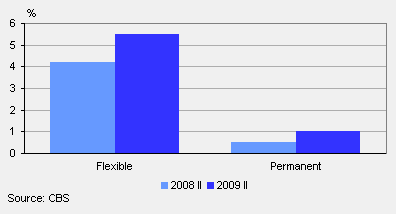Less job security for flex-workers

Employees with a flexible contract have been affected most by the recent downward trend on the labour market. In the third quarter of 2009, 5.5 percent of people with a flexible contract three months earlier had become unemployed. In the same period last year this was 4,2 percent. Flex-workers aged 25–45 years bore the brunt of the increased unemployment among flex-workers.
More flex-workers than permanent staff unemployed
People with a flexible contract are dismissed relatively often. Only 1 percent of 15–65 year-olds with a permanent contract in the second quarter of 2009 were unemployed three months later. Unemployment has risen among both flexible and permanent workers. In the same period one year previously 0.5 percent of people with a permanent contract were laid off.
Employees with flexible and permanent contracts unemployed three months later

Largest increase among 25–45 year-olds
Flexible workers aged between 25 and 45 years are most likely to become unemployed. No less than 7.1 percent of this group lost their job between the second and the third quarter of 2009. In the same period last year this was still only 5.2 percent. Young flex-workers are least likely to lose their job. In the third quarter of 2009, 4.4 percent of 15–25 year-olds who had a flexible contract in the second quarter were unemployed. Young flex-workers often work alongside school or study. If they lose their job, it does not always mean they are unemployed. More over, many young people are now deciding to stay in education longer.
Flexible workers unemployed three months later, by age

Fewer flex-workers offered permanent position
Flexible workers who do keep their jobs are less likely to be offered a permanent contract. Just over 15 percent of flex-workers in the second quarter of 2009 had a permanent contract in the third quarter of 2009. In the second quarter of 2008 this was still nearly 17 percent. Flexible workers aged between 45 and 65 years are least likely to be offered a permanent position.
Flexible workers with a permanent contract three months later

Wendy Smits and Robert de Vries